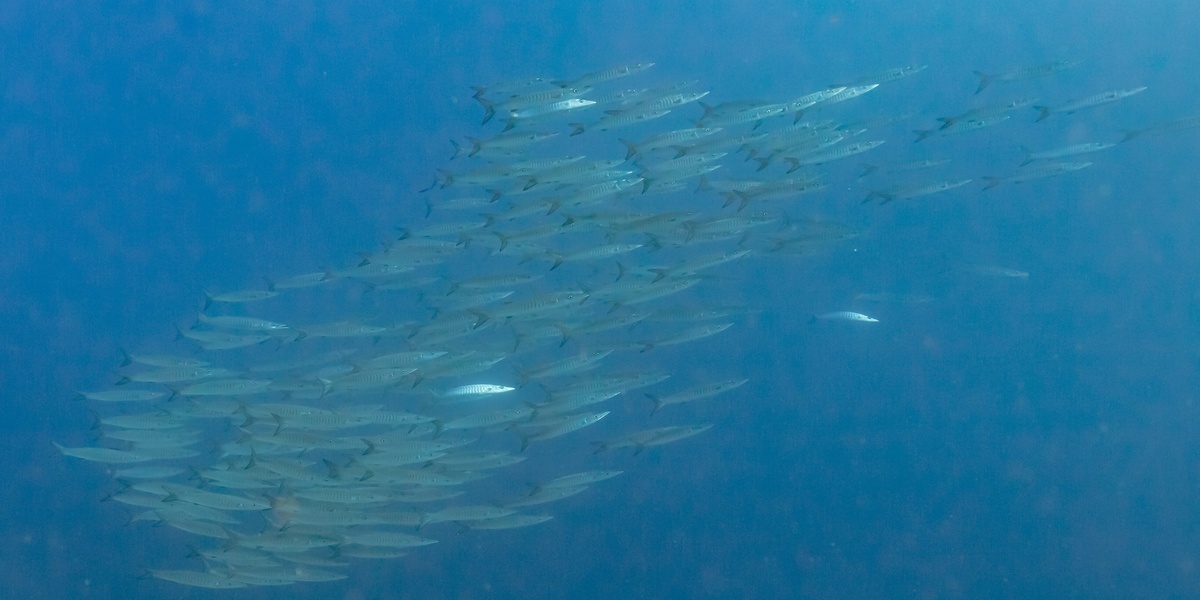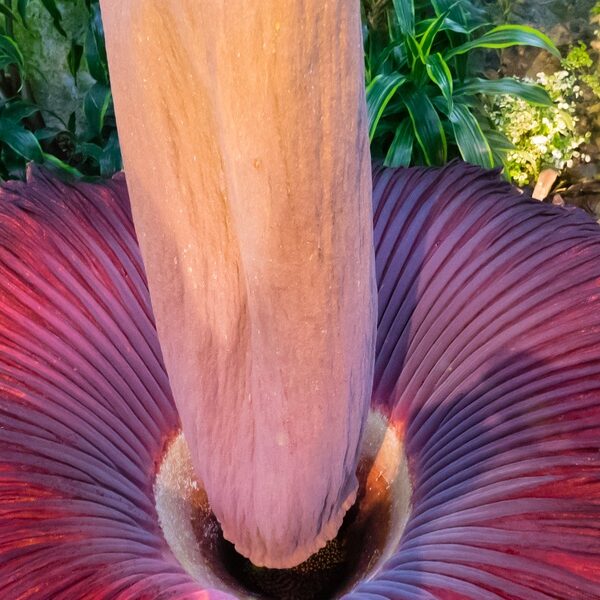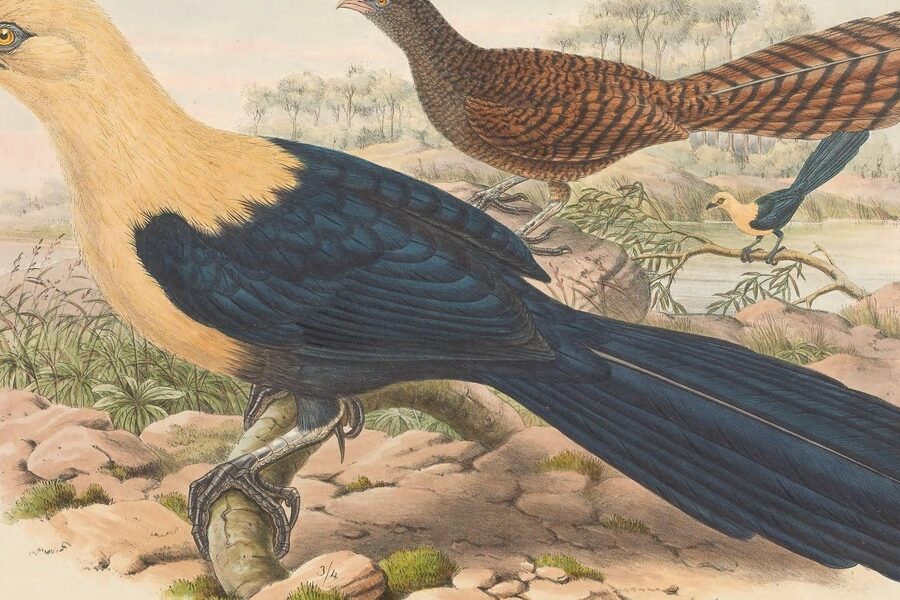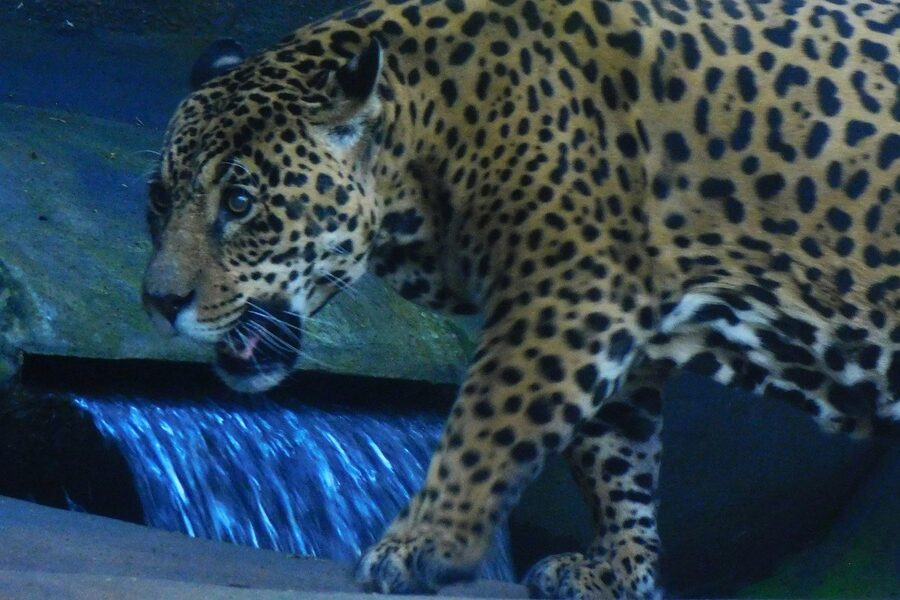Guinea-Bissau’s coastal waters, mangrove creeks and inland rivers support a mix of marine and freshwater fishes shaped by tides, seasonal floods and local fisheries. Whether you’re a curious traveler, student or angler, understanding that variety makes it easier to spot species and learn their roles in local ecosystems.
There are 94 Fish of Guinea-Bissau, ranging from Acoupa weakfish,Zebra tilapia. For each species, you’ll find below Scientific name,Max length (cm),Habitat & range.
How can I use the columns to identify and compare species?
Start with the Scientific name to avoid confusion with local common names, use Max length (cm) to set expectations for size, and check Habitat & range to know where you’re likely to encounter each fish; combined, those three fields let you narrow possibilities in the field or when consulting photos and guides.
Are any species on this list protected or important to local fisheries?
Yes — some species are targeted by subsistence and small-scale commercial fisheries while others have conservation concerns; use the scientific names from the list to look up current protection status (national regulations, IUCN) and local catch rules before fishing or trading.
Fish of Guinea-Bissau
| Name | Scientific name | Max length (cm) | Habitat & range |
|---|---|---|---|
| Guinean barracuda | Sphyraena afra | 205 | Coastal pelagic waters, often near reefs and estuaries. Throughout Guinea-Bissau’s coast. |
| Cassava croaker | Pseudotolithus senegalensis | 112 | Coastal sandy/muddy bottoms, estuaries. Widespread along the Guinea-Bissau coast. |
| Bonga shad | Ethmalosa fimbriata | 45 | Coastal waters, estuaries, lagoons. Abundant in Guinea-Bissau’s brackish systems. |
| Guinean tilapia | Tilapia guineensis | 30 | Brackish lagoons, estuaries, and river mouths. Common in coastal Guinea-Bissau. |
| West African ladyfish | Elops senegalensis | 90 | Coastal waters, estuaries, and freshwater lagoons. Found throughout Guinea-Bissau’s coastal zone. |
| Giant African threadfin | Polydactylus quadrifilis | 200 | Shallow coastal waters, sandy shores, estuaries. Common along the mainland coast. |
| Crevalle jack | Caranx hippos | 124 | Coastal and offshore waters, also enters estuaries. Widespread in Guinea-Bissau’s marine environment. |
| Lesser African threadfin | Galeoides decadactylus | 50 | Coastal soft bottoms, estuaries, and lagoons. Abundant in Guinea-Bissau’s shallow waters. |
| Bobo croaker | Pseudotolithus elongatus | 47 | Coastal waters and estuaries over mud and sand. A common catch in Guinea-Bissau. |
| African spadefish | Ephippus africanus | 45 | Coastal waters, often in bays and estuaries over sandy or muddy bottoms. |
| Madeiran sardinella | Sardinella maderensis | 37 | Coastal pelagic waters, often forming large schools. Abundant off Guinea-Bissau. |
| Bigeye grunt | Brachydeuterus auritus | 30 | Coastal waters over soft bottoms, forming large schools. Very common in Guinea-Bissau. |
| African moonfish | Selene dorsalis | 40 | Shallow coastal waters over sandy and muddy bottoms. Found along the entire coast. |
| Yellowfin tuna | Thunnus albacares | 239 | Oceanic pelagic waters, often found offshore. In Guinea-Bissau’s EEZ. |
| Atlantic bumper | Chloroscombrus chrysurus | 34 | Shallow coastal waters, bays, and estuaries, often in large schools. |
| Round sardinella | Sardinella aurita | 30 | Coastal pelagic, forming large, dense schools. Found offshore of Guinea-Bissau. |
| Bull shark | Carcharhinus leucas | 400 | Coastal marine, estuarine, and freshwater rivers. Known from Bijagós and major rivers. |
| Smooth-hound | Mustelus mustelus | 164 | Coastal waters over continental shelves. Found in Guinea-Bissau’s marine territory. |
| White grouper | Epinephelus aeneus | 120 | Rocky and sandy bottoms from shallow water to 200m. Bijagós Archipelago reefs. |
| Red pandora | Pagellus bellottii | 42 | Coastal waters over various bottoms. A common sea bream in Guinea-Bissau. |
| Guinean sole | Cynoglossus senegalensis | 66 | Shallow sandy and muddy bottoms in coastal waters. Widespread along the coast. |
| Red cichlid | Hemichromis bimaculatus | 10 | Freshwater rivers and streams. Widespread in Guinea-Bissau’s inland waters. |
| Fat-head sleeper | Dormitator lebretonis | 9 | Brackish and freshwater lagoons, and river mouths. Common in coastal wetlands. |
| West African lungfish | Protopterus annectens | 100 | Freshwater swamps and floodplains. Found in inland wetlands of Guinea-Bissau. |
| Common guitarfish | Rhinobatos rhinobatos | 147 | Shallow coastal waters with sandy or muddy bottoms. Common along the coast. |
| Guinean pufferfish | Sphoeroides marmoratus | 25 | Coastal waters, estuaries, often over sand or seagrass beds. |
| Zebra tilapia | Tilapia buttikoferi | 41 | Freshwater and brackish rivers and lagoons. Found in western Guinea-Bissau. |
| African moony | Monodactylus sebae | 25 | Brackish estuaries and mangrove swamps, sometimes entering freshwater. |
| Senegal jack | Caranx senegallus | 100 | Coastal waters, commonly entering estuaries and lagoons. Throughout Guinea-Bissau. |
| African red snapper | Lutjanus agennes | 90 | Coastal waters, rocky reefs, and estuaries. Common in the Bijagós Archipelago. |
| Gorean snapper | Lutjanus goreensis | 80 | Coastal waters, particularly over rocky bottoms and reefs. Bijagós Archipelago. |
| Senegal kob | Pseudotolithus brachygnathus | 230 | Coastal waters over mud and sand. Widespread along the Guinea-Bissau coast. |
| Longneck croaker | Pseudotolithus typus | 100 | Coastal waters, estuaries, over soft bottoms. A common commercial species. |
| Guinean electric ray | Torpedo mackayana | 40 | Shallow coastal waters, on sandy or muddy bottoms. Throughout the coastal zone. |
| African wedgefish | Rhynchobatus luebberti | 300 | Coastal waters, often on soft bottoms. Found along the Guinea-Bissau coast. |
| Banana cichlid | Tilapia tholloni | 18 | Freshwater rivers and lagoons. Reported from Guinea-Bissau’s river systems. |
| Upside-down catfish | Synodontis batensoda | 50 | Freshwater rivers and floodplains. In major rivers like the Geba and Corubal. |
| African butter catfish | Schilbe mystus | 40 | Open waters of rivers and lakes. Found in Guinea-Bissau’s main river systems. |
| North African catfish | Clarias gariepinus | 170 | Freshwater rivers, lakes, swamps; air-breather. Widespread in inland Guinea-Bissau. |
| Guinean sprat | Pellonula leonensis | 10 | Coastal lagoons, estuaries, and lower river courses. Abundant in brackish waters. |
| Southern pink-shrimp goby | Cryptocentrus malindiensis | 9 | Marine; burrows in sand near reefs. Likely in Bijagós coastal waters. |
| West African mudskipper | Periophthalmus papilio | 17 | Mangrove swamps and intertidal mudflats. Abundant in Guinea-Bissau’s estuaries. |
| Lionhead cichlid | Steatocranus tinanti | 13 | Fast-flowing freshwater rivers and streams. Inhabits rivers in eastern Guinea-Bissau. |
| Barred spiny-eel | Mastacembelus liberiensis | 29 | Freshwater streams and rivers, often in vegetation. Found in Guinea-Bissau’s inland waters. |
| West African flying fish | Cheilopogon nigricans | 30 | Oceanic surface waters. Found offshore in Guinea-Bissau’s EEZ. |
| Spotted eagle ray | Aetobatus narinari | 330 | Coastal and oceanic waters, often near reefs. Present in the Bijagós Archipelago. |
| Atlantic sailfish | Istiophorus albicans | 315 | Oceanic pelagic waters. Found offshore in Guinea-Bissau’s EEZ. |
| Blue marlin | Makaira nigricans | 500 | Oceanic pelagic waters. Found far offshore in Guinea-Bissau’s EEZ. |
| Wahoo | Acanthocybium solandri | 250 | Oceanic surface waters. Found in offshore marine territory. |
| Dolphin fish | Coryphaena hippurus | 210 | Oceanic surface waters, often near floating objects. Widespread offshore. |
| Nurse shark | Ginglymostoma cirratum | 300 | Shallow coastal waters, reefs, and sand flats. Bijagós Archipelago. |
| Scalloped hammerhead | Sphyrna lewini | 430 | Coastal and semi-oceanic waters. Found throughout Guinea-Bissau’s marine zone. |
| Tiger shark | Galeocerdo cuvier | 750 | Coastal and pelagic waters. A wide-ranging predator in Guinea-Bissau’s EEZ. |
| Sicklefin lemon shark | Negaprion acutidens | 380 | Shallow coastal waters, bays, and estuaries. Common around the Bijagós. |
| Atlantic tarpon | Megalops atlanticus | 250 | Coastal waters, estuaries, and freshwater rivers. Common in Guinea-Bissau’s coastal systems. |
| Bonefish | Albula vulpes | 104 | Shallow coastal flats, mangroves, and estuaries. Present in the Bijagós Archipelago. |
| African threadfish | Alectis alexandrina | 100 | Coastal waters, often near the bottom. Found along the Guinea-Bissau coast. |
| Guinean amberjack | Seriola carpenteri | 73 | Pelagic over the continental shelf. Found in Guinea-Bissau’s offshore waters. |
| Blue runner | Caranx crysos | 70 | Coastal and offshore waters. A common schooling jack in Guinea-Bissau. |
| Mottled grouper | Mycteroperca rubra | 144 | Rocky bottoms and reefs. Found in the Bijagós Archipelago. |
| Canary drum | Umbrina canariensis | 63 | Coastal waters over sand and mud. A common croaker in local fisheries. |
| Guachanche barracuda | Sphyraena guachancho | 100 | Coastal waters, estuaries, and turbid areas. Widespread along the coast. |
| Horse-eye jack | Caranx latus | 101 | Coastal waters, reefs, and sometimes offshore. Found throughout Guinea-Bissau. |
| Blackchin tilapia | Sarotherodon melanotheron | 28 | Brackish lagoons and estuaries. Abundant in Guinea-Bissau’s coastal wetlands. |
| Brycinus longipinnis | Brycinus longipinnis | 13 | Freshwater rivers. Common in Guinea-Bissau’s inland systems. |
| African pike | Hepsetus odoe | 70 | Freshwater rivers and lagoons. Found in quiet, vegetated waters in Guinea-Bissau. |
| Red-eye tetra | Arnoldichthys spilopterus | 10 | Freshwater streams and rivers. Native to West Africa, including Guinea-Bissau. |
| False triggerfish | Balistes capriscus | 60 | Coastal waters, over rocky bottoms and reefs. Present in the Bijagós Archipelago. |
| Law croaker | Pseudotolithus senegallus | 50 | Coastal waters, estuaries, over soft bottoms. A key commercial catch. |
| Sompat grunt | Pomadasys jubelini | 60 | Coastal waters and estuaries, especially over mud. A common food fish. |
| Largemouth black bass | Micropterus salmoides | 97 | Introduced to some freshwater reservoirs. Presence in Guinea-Bissau unconfirmed but possible. |
| Five-spot cichlid | Hemichromis fasciatus | 27 | Freshwater rivers and lagoons. Widespread in Guinea-Bissau’s river systems. |
| Cunene tilapia | Tilapia ruweti | 10 | Freshwater rivers and floodplains. Native to the region including Guinea-Bissau. |
| Binga-tonga | Bathybagrus tetraspilus | 24 | Deep channels of large freshwater rivers. Found in major rivers of Guinea-Bissau. |
| Short-body cichlid | Alcolapia alcalica | 12 | Freshwater systems. A member of the diverse cichlid family found here. |
| Plain-body cichlid | Limnotilapia dardennii | 26 | Freshwater river habitats. Part of the native cichlid fauna. |
| Long-snout killifish | Fundulus longirostris | 8 | Freshwater pools, streams, and brackish estuaries. In coastal freshwater bodies. |
| Guinean killifish | Fundulopanchax gularis | 6 | Small freshwater streams and pools, often in forests. Native to the region. |
| Threespot barb | Enteromius trispilos | 8 | Freshwater rivers and streams. A common small cyprinid in Guinea-Bissau. |
| West African catshark | Scyliorhinus cervigoni | 76 | Deep coastal waters on the continental slope. Found offshore of Guinea-Bissau. |
| African sawtail catshark | Galeus polli | 46 | Deepwater on the continental slope. Lives in deep waters off the coast. |
| Tonguetied sole | Cynoglossus canariensis | 40 | Coastal waters on sand/mud bottoms. Widespread along the Guinea-Bissau coast. |
| Angelshark | Squatina squatina | 244 | Coastal waters, on sandy or muddy bottoms. Historically present, now rare. |
| Longfin mako | Isurus paucus | 427 | Oceanic, pelagic, deep waters. Found far offshore in Guinea-Bissau’s EEZ. |
| Bigeye thresher | Alopias superciliosus | 488 | Oceanic and coastal pelagic waters. Occurs in Guinea-Bissau’s marine territory. |
| Dusky shark | Carcharhinus obscurus | 400 | Coastal and oceanic waters. A wide-ranging shark found in Guinea-Bissau’s EEZ. |
| Sand tiger shark | Carcharias taurus | 320 | Shallow coastal waters, reefs, and wrecks. Likely present in Guinea-Bissau. |
| Oceanic whitetip shark | Carcharhinus longimanus | 300 | Oceanic pelagic, warm surface waters. Inhabits offshore waters of Guinea-Bissau. |
| Silky shark | Carcharhinus falciformis | 350 | Oceanic and coastal pelagic waters. Found in Guinea-Bissau’s EEZ. |
| Smalltooth sawfish | Pristis pectinata | 760 | Shallow coastal waters, estuaries, and river mouths. Historically in Guinea-Bissau. |
| African wedgefish | Rhynchobatus luebberti | 300 | Coastal waters, on sandy or muddy bottoms. Present in Guinea-Bissau. |
| Acoupa weakfish | Cynoscion acoupa | 110 | Coastal waters, estuaries, over mud and sand. A valuable catch in Guinea-Bissau. |
| Meagre | Argyrosomus regius | 230 | Coastal waters, feeding near the seabed and in the water column. |
| Porcupinefish | Diodon hystrix | 91 | Coastal waters, reefs, and seagrass beds. Found in the Bijagós Archipelago. |
Images and Descriptions
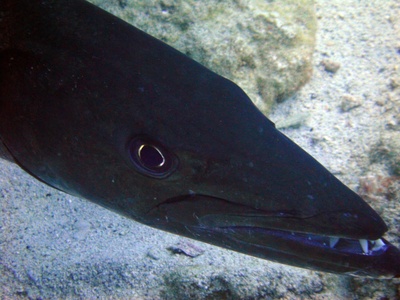
Guinean barracuda
A large, formidable predator with a pike-like body and sharp teeth. It is a prized game fish and is important in local fisheries, though its flesh is sometimes associated with ciguatera poisoning in other regions.
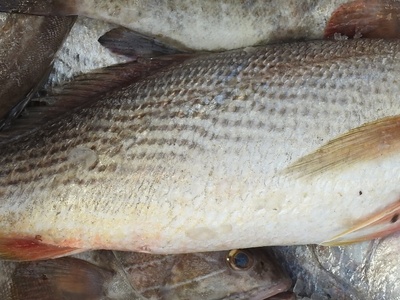
Cassava croaker
A large, silvery croaker highly valued in West African fisheries, often smoked or dried. Its populations are heavily exploited, raising concerns about sustainability and management, particularly around the Bijagós Archipelago.
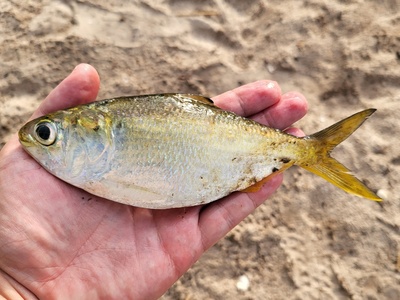
Bonga shad
A key species for artisanal fisheries, forming large schools in estuaries. It’s a vital source of protein, commonly smoked and sold in local markets. Its abundance is closely tied to the health of mangrove ecosystems.
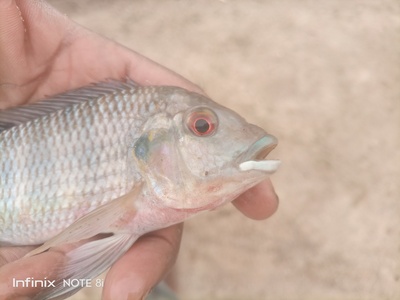
Guinean tilapia
A hardy, adaptable cichlid that tolerates a wide range of salinity. It is a very important food fish for coastal communities and is also used in aquaculture due to its resilience and rapid growth.
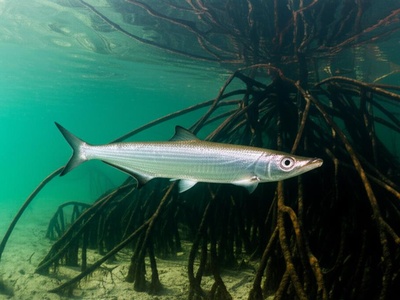
West African ladyfish
A sleek, silvery fish known for its acrobatic leaps when hooked. While bony, it is eaten locally. It plays a crucial role as both predator and prey in the food webs of mangrove-lined estuaries.
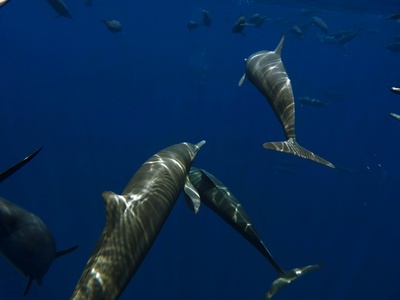
Giant African threadfin
A very large and commercially important fish, recognized by the long, thread-like rays below its pectoral fins. It’s a prized catch for both artisanal and sport fishers and is a delicacy in local cuisine.
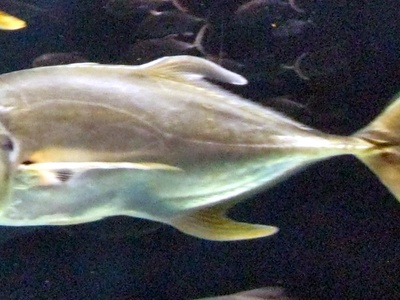
Crevalle jack
A powerful, fast-swimming predator often found in schools. It is a popular target for sport anglers and a significant catch in commercial fisheries, valued for its strong fight and firm flesh.
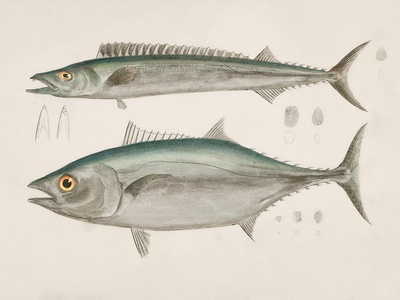
Lesser African threadfin
A smaller relative of the giant threadfin, this species is extremely important in the shrimp trawl bycatch and artisanal fisheries. It’s a common and affordable food fish in coastal markets, often sold fresh or smoked.
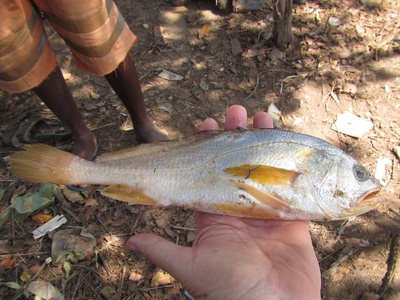
Bobo croaker
Another important commercial croaker, smaller than the cassava croaker but caught in large numbers. It’s a staple food fish, valued for its swim bladder which is processed into isinglass for export.
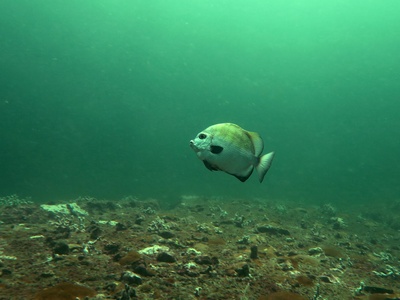
African spadefish
A deep-bodied, silvery fish with faint vertical bars, often found in schools. It is a common component of artisanal catches and is a popular food fish in local markets along the coast.
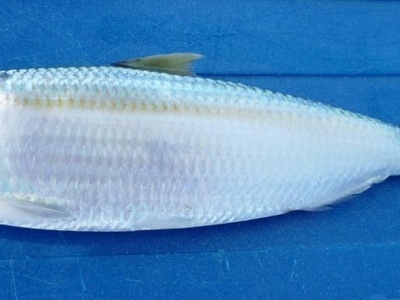
Madeiran sardinella
A crucial species for commercial and artisanal purse seine fisheries. This small, silvery fish is a primary source of protein for coastal populations, often grilled, smoked, or used for fish meal and oil.
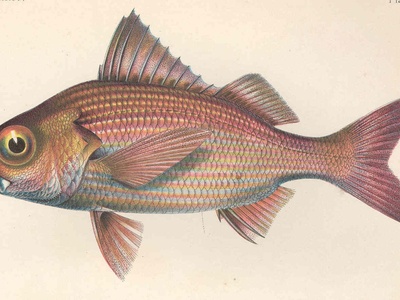
Bigeye grunt
One of the most abundant demersal fish, this small grunt is a staple of the artisanal fishery and trawl bycatch. Despite its small size, its sheer numbers make it a vital and affordable food source.
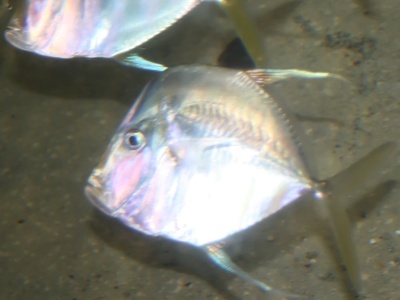
African moonfish
A striking, diamond-shaped fish with a highly compressed, silvery body. Juveniles have long, filamentous dorsal and anal fin rays. It is a common catch in beach seines and is considered a good food fish.
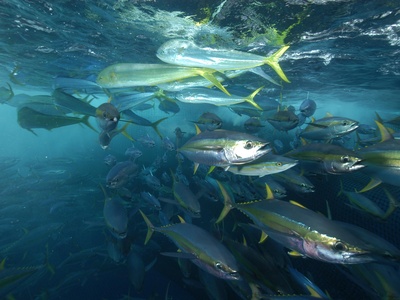
Yellowfin tuna
A large, fast-swimming tuna prized globally for sushi and canning. It supports a significant industrial fishery in Guinea-Bissau’s offshore waters, representing a valuable economic resource for the country through fishing licenses.
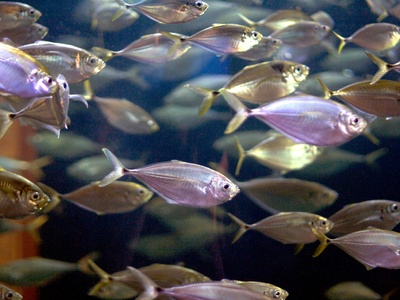
Atlantic bumper
A small, deep-bodied jack with a distinctive yellow tail and a black spot on the gill cover. It is very abundant and forms a significant part of the artisanal catch, serving as an important and accessible food fish.
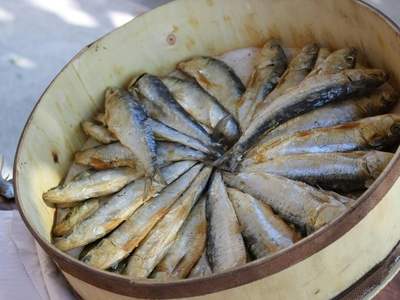
Round sardinella
Similar to the Madeiran sardinella, this species is a cornerstone of the pelagic fishery. It is a vital food source and economic driver, though its populations can fluctuate dramatically with changing ocean conditions.
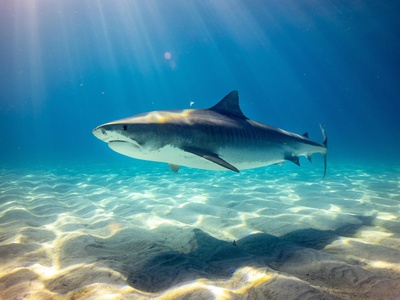
Bull shark
A large, aggressive shark famous for its ability to travel far up freshwater rivers. It is an apex predator in Guinea-Bissau’s coastal and riverine ecosystems. Its presence highlights the unique biodiversity of the region.
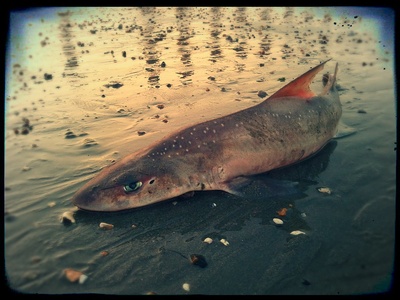
Smooth-hound
A small, slender shark lacking the typical sharp teeth, instead having flattened, crushing plates for eating crustaceans. It is often caught by local fishers and its meat is consumed, though it is vulnerable to overfishing.
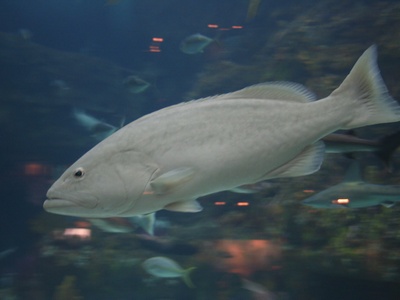
White grouper
A large, predatory grouper that is a highly sought-after commercial and recreational species. Known for its excellent taste, it has been heavily fished and is now considered a vulnerable species, requiring careful management.
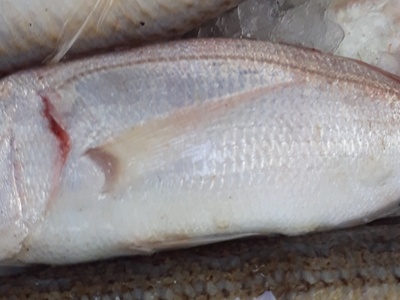
Red pandora
A pinkish-silver sea bream that is a very common and important target for both artisanal and commercial trawl fisheries. It is a popular table fish in local markets due to its delicate flavor.
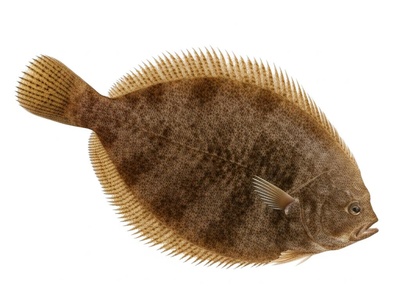
Guinean sole
A type of tonguefish, a flatfish with both eyes on the left side of its head. It is a valuable commercial species, caught mainly by trawlers and prized for its fine-textured flesh.
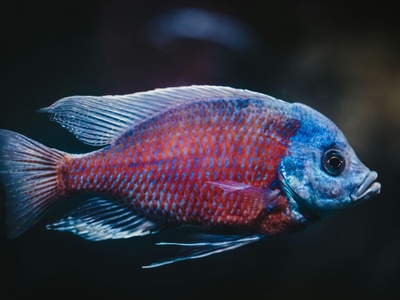
Red cichlid
A small but brightly colored cichlid, known for its vibrant red breeding coloration. It is a popular aquarium fish internationally and plays a role in the ecology of freshwater streams as an insectivore.
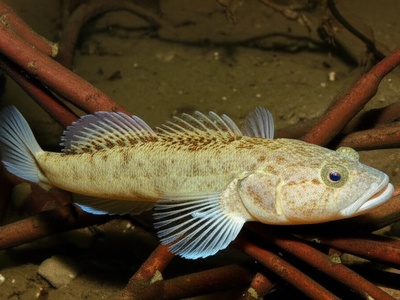
Fat-head sleeper
A small, goby-like fish that is often found among mangrove roots and in muddy pools. It is part of the rich biodiversity of the estuarine ecosystem and is sometimes caught for local consumption.
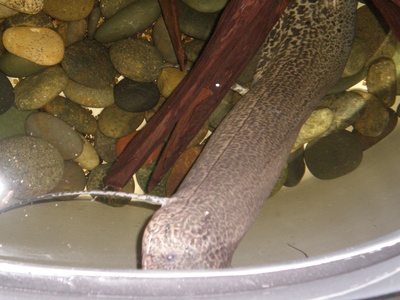
West African lungfish
An ancient fish that can breathe air using a lung-like organ and survive droughts by burrowing in the mud and forming a cocoon. It is a fascinating example of evolutionary adaptation and is a local food source.
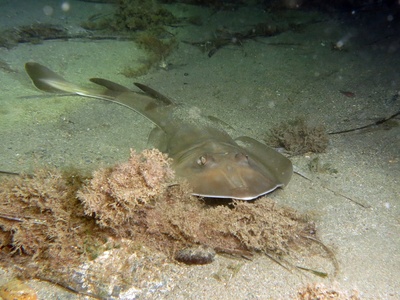
Common guitarfish
A ray with a shark-like body, often called a “sand shark”. It is frequently caught as bycatch in trawl fisheries. Its fins are highly valued in the international shark fin trade, making it critically endangered.
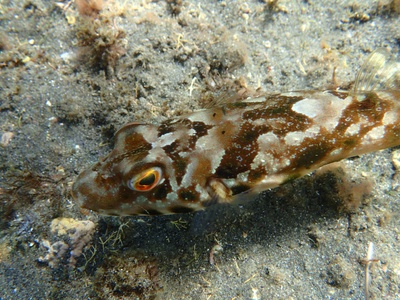
Guinean pufferfish
A small pufferfish known for its ability to inflate its body with water as a defense mechanism. While some pufferfish are toxic, this species contributes to the diverse fauna of the coastal ecosystem.
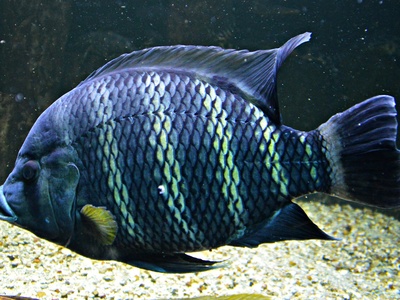
Zebra tilapia
A striking cichlid with bold black and white vertical stripes. Its aggressive nature and attractive appearance make it a popular but challenging fish for aquarists. It is also an important local food fish.
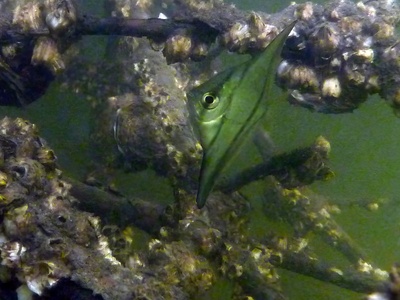
African moony
A beautiful, silver, diamond-shaped fish with black vertical bars. It is very popular in the aquarium trade. In Guinea-Bissau, they are a common sight in the rich mangrove habitats of the Bijagós.
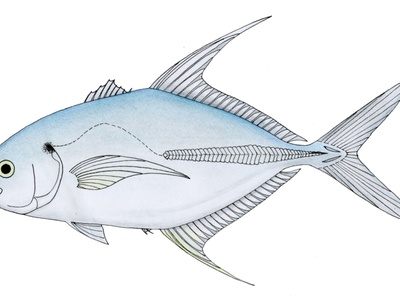
Senegal jack
A large, silvery jack that is similar to the crevalle jack but generally found in more coastal, turbid waters. It is an important predator and a valued catch for local fishermen.
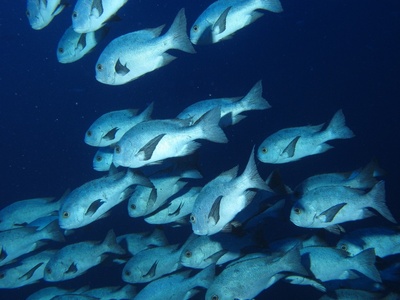
African red snapper
A powerful snapper with a reddish hue, often found near mangrove roots as a juvenile. It is a prized food fish known for its firm, white meat, making it a target for both commercial and sport fishing.
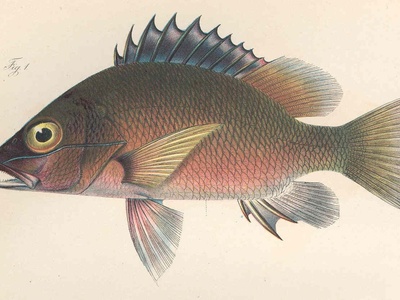
Gorean snapper
Another important snapper species, often found alongside the African red snapper. It is a key predator on reefs and a significant component of the artisanal fishery, valued for its quality as a food fish.
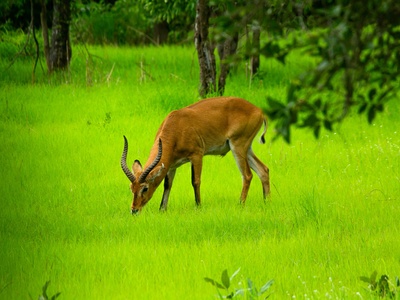
Senegal kob
One of the largest croakers in the region, reaching over two meters. This massive fish is a top predator and a trophy catch, but it is now critically endangered due to intense fishing pressure.
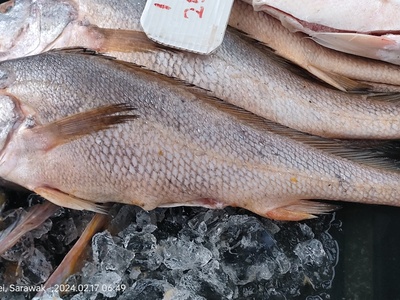
Longneck croaker
A large croaker species that is a staple in the West African fishery. It is distinguished by its more elongated body. Like other large croakers, its population is under significant fishing pressure.
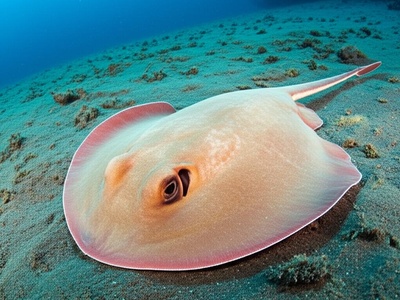
Guinean electric ray
A fascinating ray capable of generating a powerful electric shock to stun prey and deter predators. It spends most of its time buried in the sand, ambushing small fish. A unique part of the demersal fauna.
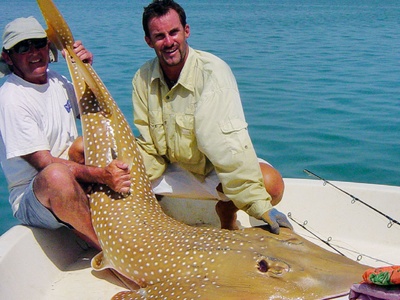
African wedgefish
A very large ray with a shark-like appearance, belonging to the guitarfish family. It is critically endangered due to being targeted for its high-value fins and as bycatch in trawls.
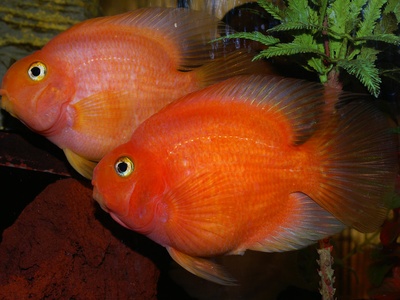
Banana cichlid
A medium-sized cichlid that is an important food source in inland communities. It is known for its parental care, with both parents guarding the eggs and fry. Adaptable and widespread in the region.
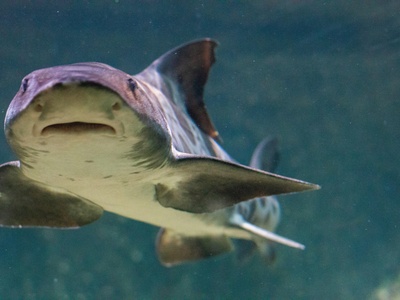
Upside-down catfish
A distinctive catfish known for its habit of swimming upside-down. This behavior is thought to help it feed on algae and other organisms on the underside of leaves and logs. An intriguing freshwater species.
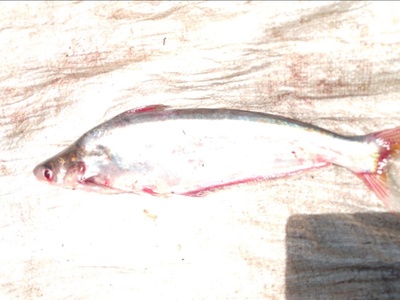
African butter catfish
A silvery, scaleless catfish that is an important food fish in inland fisheries. It often forms schools and is caught using various net methods, providing a key source of protein for riverine communities.
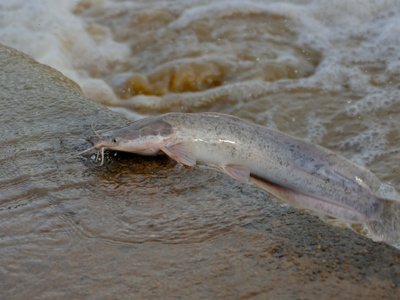
North African catfish
A large, hardy catfish capable of breathing air and “walking” on land for short distances. It is extremely important for aquaculture and as a food fish due to its resilience and rapid growth.
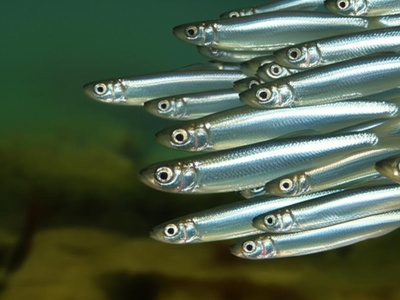
Guinean sprat
A small, herring-like fish that forms large schools in estuarine environments. It is a vital link in the food chain and supports important small-scale fisheries, often dried for sale.
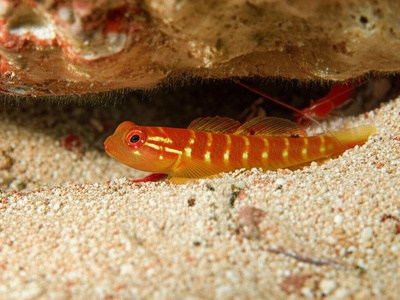
Southern pink-shrimp goby
A small, colorful goby that shares a burrow with a snapping shrimp in a classic symbiotic relationship. The shrimp maintains the burrow while the goby stands guard. Represents the high biodiversity of reef habitats.
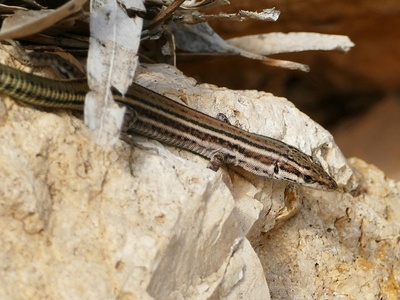
West African mudskipper
An amphibious fish that can live out of water, using its fins to “walk” on mud and breathing through its skin. It is a common and iconic inhabitant of the mangrove ecosystems.
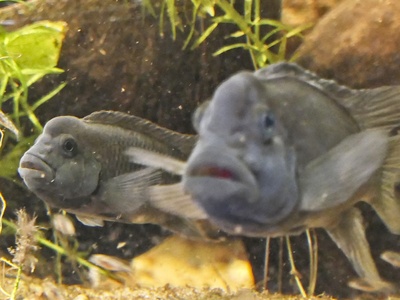
Lionhead cichlid
A unique cichlid adapted to strong currents, with a reduced swim bladder that helps it stay on the river bottom. It is a specialized bottom-dweller, often hiding among rocks.
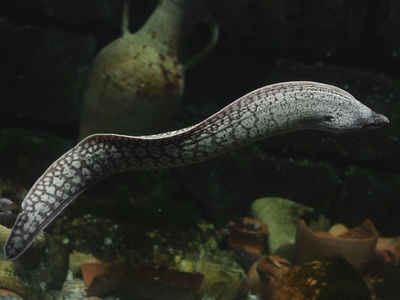
Barred spiny-eel
An eel-like fish, though not a true eel, with a long, pointed snout and a series of sharp spines along its back. It is a secretive, nocturnal predator of small invertebrates.
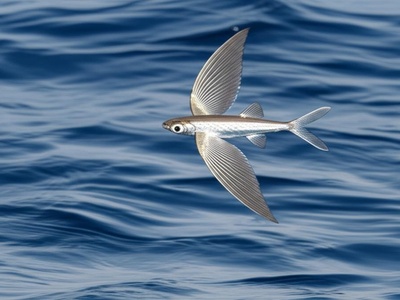
West African flying fish
A pelagic fish with large, wing-like pectoral fins that allow it to leap from the water and glide for long distances to escape predators. A common sight in the open ocean.
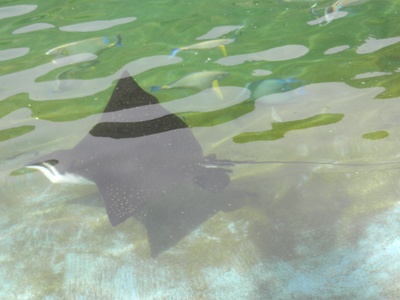
Spotted eagle ray
A large, graceful ray easily identified by the white spots on its black back. It is a powerful swimmer, sometimes leaping clear of the water. It feeds on mollusks and crustaceans on the seafloor.
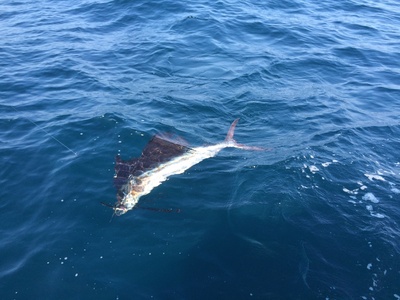
Atlantic sailfish
A magnificent billfish known for its incredible speed and enormous, sail-like dorsal fin. It is a premier sport fish, supporting a valuable recreational fishing industry in the region.
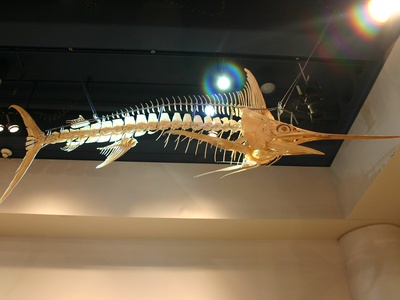
Blue marlin
One of the largest and most powerful fish in the ocean, the blue marlin is a legendary big-game trophy fish. Its presence highlights the rich pelagic ecosystem in Guinea-Bissau’s offshore waters.
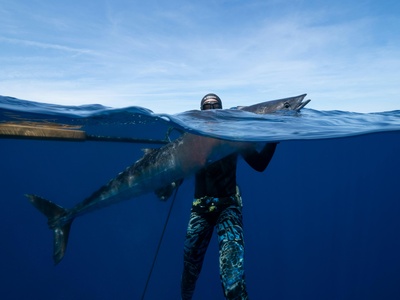
Wahoo
A long, streamlined predator renowned for its blistering speed and high-quality meat. It is a highly prized catch for sport fishermen and is also taken in commercial fisheries.
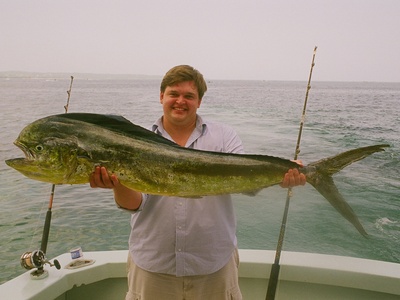
Dolphin fish
Also known as mahi-mahi, this colorful, fast-growing fish is a popular target for sport and commercial fisheries. It is recognized by its vibrant green, blue, and yellow colors and blunt head on males.
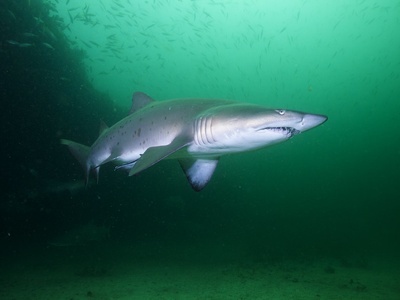
Nurse shark
A sluggish, bottom-dwelling shark that is generally harmless unless provoked. It rests on the seafloor during the day and forages for invertebrates at night. An important part of the reef ecosystem.
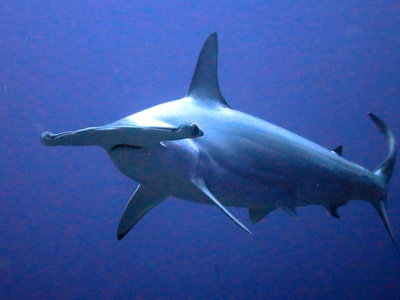
Scalloped hammerhead
An iconic shark with a distinctive hammer-shaped head. It often forms large schools. This species is critically endangered globally due to high demand for its fins and overfishing.
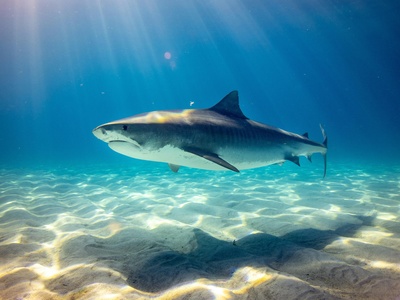
Tiger shark
A very large and indiscriminate predator, known for eating almost anything. It is a powerful apex predator found in the region’s waters but is near threatened due to fishing pressures.
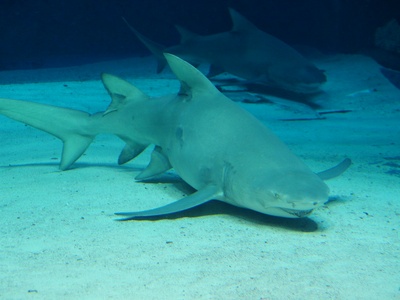
Sicklefin lemon shark
A large, stout shark often found in mangrove habitats, which serve as crucial nursery areas. The Bijagós Archipelago is a globally important sanctuary for this and other shark species.
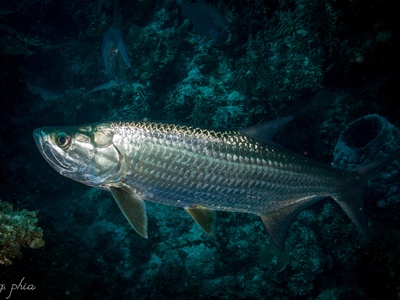
Atlantic tarpon
A huge, silvery fish famous for its spectacular leaps and fighting ability, making it a world-class game fish. It can gulp air, allowing it to survive in low-oxygen waters like mangrove channels.
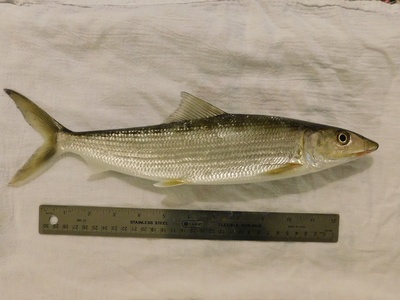
Bonefish
A sleek, silver fish prized by sport anglers for its speed and challenging nature on light tackle. It forages in shallow, sandy areas for crustaceans, making the Bijagós a prime destination for fly fishing.
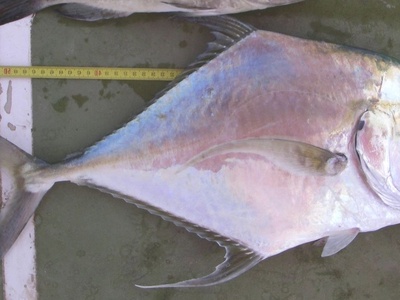
African threadfish
A striking jack with a very deep, compressed body. Juveniles have extremely long, trailing filaments on their fins. It is an important species in local fisheries and a unique-looking fish.
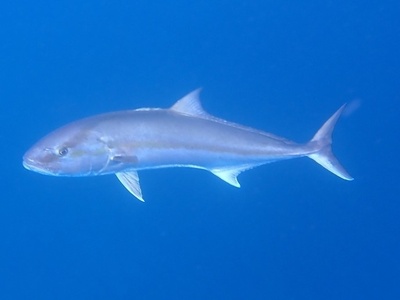
Guinean amberjack
A smaller species of amberjack that is a fast-swimming predator, often found in schools. It is a target for both commercial and recreational fisheries in the region.
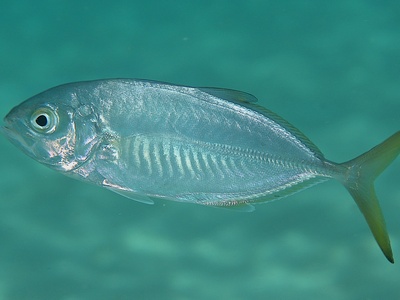
Blue runner
A common, fast-swimming jack that forms large schools. It is an important species for both artisanal and commercial fisheries and is a key predator on smaller fish like sardines.
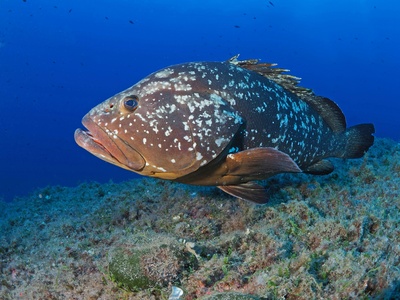
Mottled grouper
A large grouper species that is a top predator on the reefs. It is valued as a food fish but is vulnerable to overfishing, especially spearfishing, due to its territorial nature.
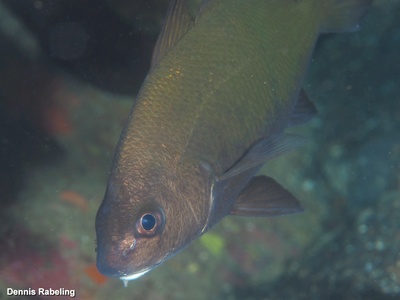
Canary drum
A medium-sized croaker or drum, recognized by a short, single barbel on its chin. It is a common catch in trawl fisheries and is an important component of the local fish supply.
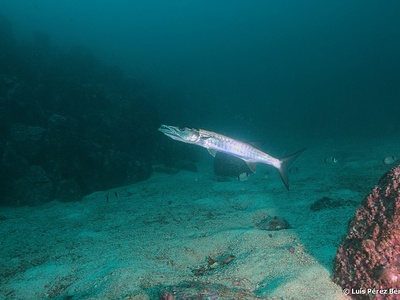
Guachanche barracuda
A smaller species of barracuda, often forming schools over muddy bottoms. It is an important commercial species, caught in large numbers by artisanal fishers.
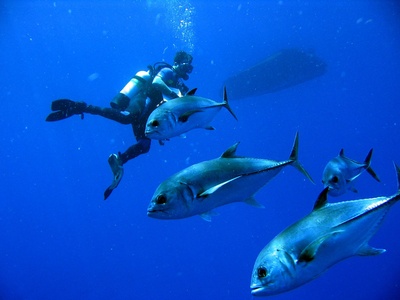
Horse-eye jack
A large jack with a prominent, large eye. It is a strong fighter, popular with sport anglers, and also an important food fish caught in a variety of local fisheries.
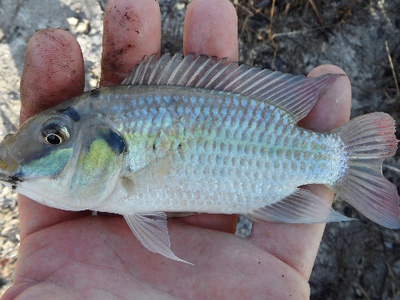
Blackchin tilapia
A tilapia species known for the dark pigmentation on its lower jaw. It is a mouthbrooder, with males incubating eggs in their mouths. Very important in aquaculture and artisanal fisheries.
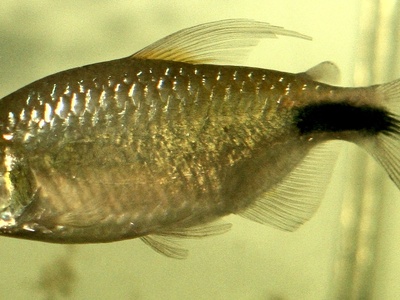
Brycinus longipinnis
A small, active characin (related to tetras) with long, flowing fins, especially in males. It is popular in the aquarium hobby and is part of the diverse fish fauna of the region’s rivers.
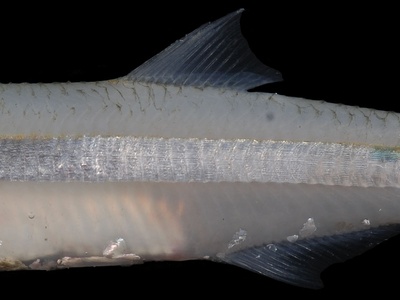
African pike
An ambush predator resembling the northern pike, with a long body and tooth-filled jaws. It is the only member of its family and is an important predator in African freshwater ecosystems.
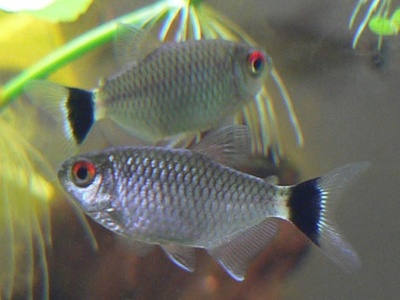
Red-eye tetra
A beautiful, silvery tetra with a distinctive black spot on its dorsal fin and a bright red eye. It is highly sought after for the aquarium trade, representing a potential economic resource.
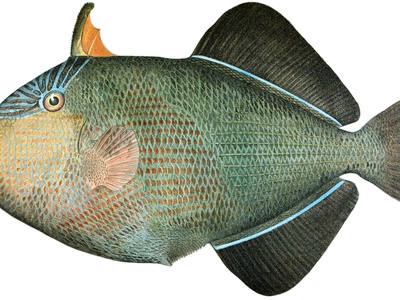
False triggerfish
A common triggerfish that can lock its first dorsal spine in place as a defense. It has a tough skin and powerful jaws used for crushing shells. It’s an important part of the reef community.
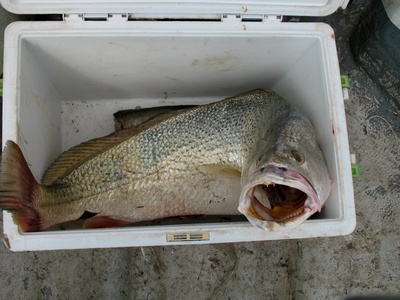
Law croaker
Not to be confused with the Cassava croaker, this is another commercially significant croaker species. It is a staple food fish and supports many livelihoods in the coastal fishing sector of Guinea-Bissau.
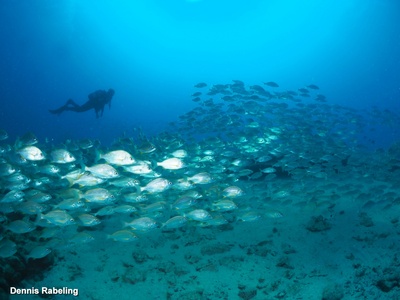
Sompat grunt
A large grunt species that is an important target for artisanal fishers. It is known for the grunting sound it produces by grinding its pharyngeal teeth. A common sight in local fish markets.
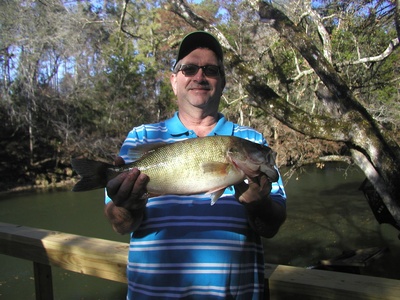
Largemouth black bass
An introduced predatory fish prized for sport fishing. Its potential presence could impact native fish communities through competition and predation. Monitoring is needed to track its spread.
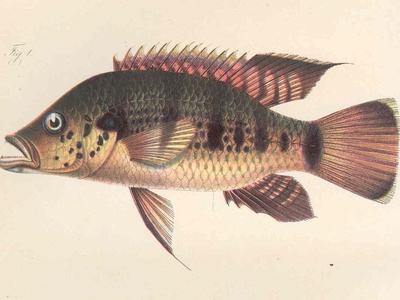
Five-spot cichlid
A larger, predatory relative of the red cichlid, known for the five dark spots along its side. It is an aggressive predator of smaller fish and insects, playing a key role in riverine food webs.
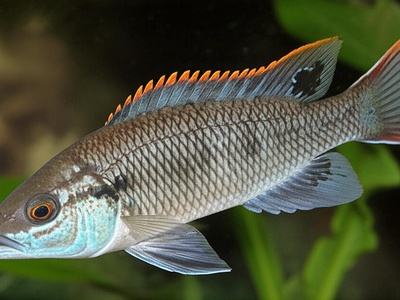
Cunene tilapia
A small cichlid species that is part of the diverse tilapia group in the region’s freshwater systems. It contributes to local subsistence fisheries and the overall aquatic biodiversity.
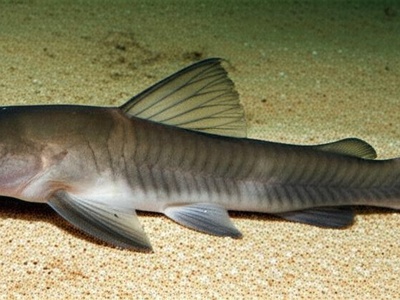
Binga-tonga
A small, bottom-dwelling catfish that inhabits the deeper parts of rivers. Little is known about its biology, highlighting the need for more research on the country’s freshwater fish diversity.
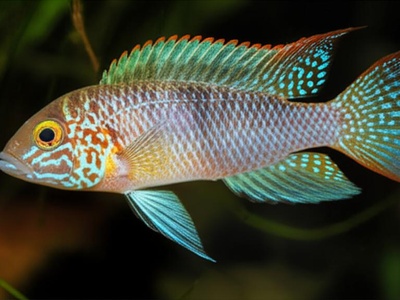
Short-body cichlid
A small cichlid adapted to specific water conditions. The diversity of cichlids in Guinea-Bissau’s rivers is significant, with many species playing roles in local ecosystems and fisheries.
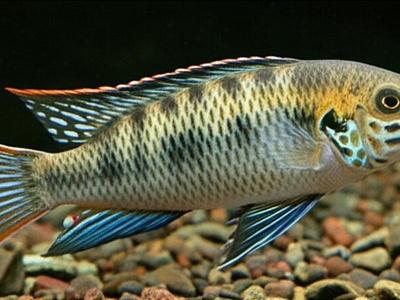
Plain-body cichlid
A medium-sized cichlid that feeds primarily on algae and plant matter scraped from rocks. It helps control algal growth and is part of the complex food web in the river systems.
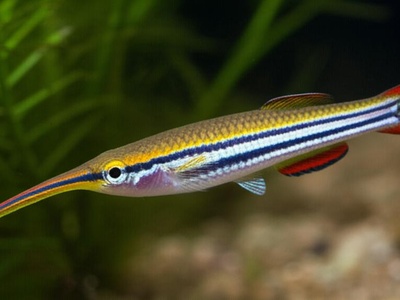
Long-snout killifish
A small, surface-dwelling killifish adapted to a variety of habitats. Killifish are known for their bright colors and resilience, often surviving in temporary pools. They are important for mosquito control.
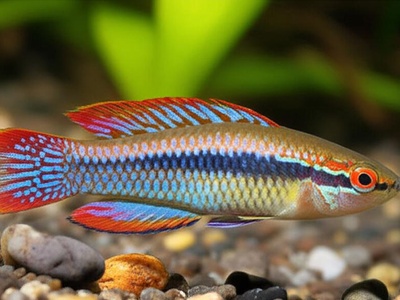
Guinean killifish
A small, brightly colored killifish popular among aquarium enthusiasts. Its presence indicates healthy, unpolluted small stream habitats. These fish lay drought-resistant eggs in the substrate.
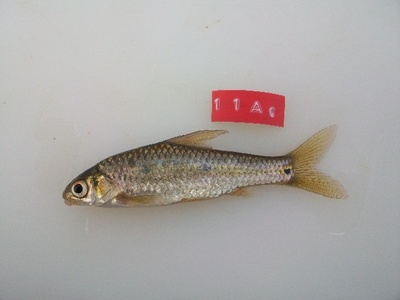
Threespot barb
A small, active barb with three distinct spots along its side. These fish often form schools and are an important part of the riverine ecosystem, feeding on small insects and algae.
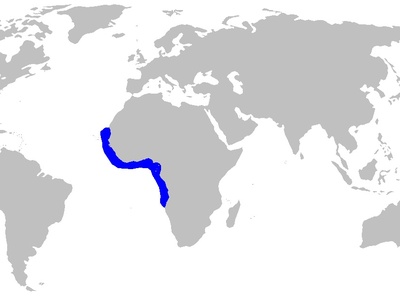
West African catshark
A small, deepwater shark that lives on or near the seabed. It is poorly known but is part of the diverse deep-sea fauna in Guinea-Bissau’s exclusive economic zone. Often taken as bycatch.
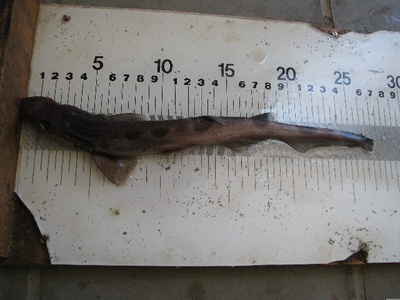
African sawtail catshark
Another small, deep-sea catshark that is a common but little-studied inhabitant of the continental slope. It feeds on small fish and crustaceans in the dark, cold waters of the deep.
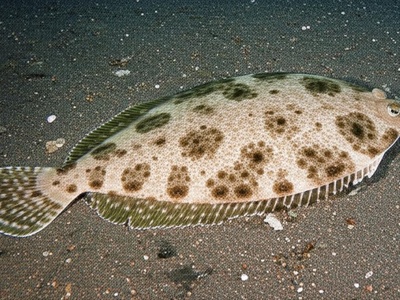
Tonguetied sole
A common flatfish in the region’s trawl fisheries. Like other tonguefishes, it lies camouflaged on the seabed, ambushing small prey. It is an important commercial species.
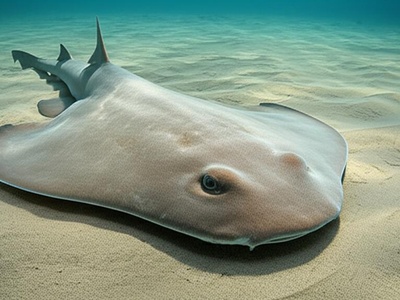
Angelshark
A unique, flattened shark that looks like a ray. It buries itself in the sand to ambush prey. This species is critically endangered throughout its range due to intense bottom trawling.
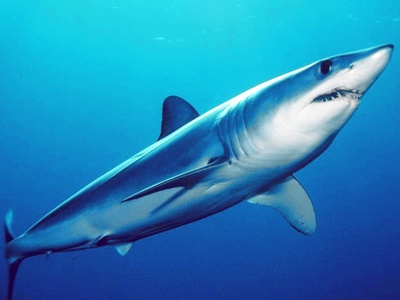
Longfin mako
A large, powerful shark related to the more famous shortfin mako. It is a swift predator of the open ocean but is now endangered due to overfishing, primarily as bycatch in tuna longline fisheries.
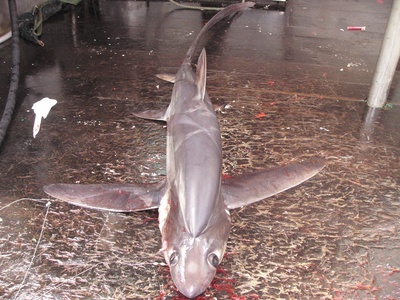
Bigeye thresher
A large shark easily recognized by its enormous eyes and extremely long tail fin, which it uses to stun prey. This deep-water species is vulnerable to overfishing from longline fisheries.
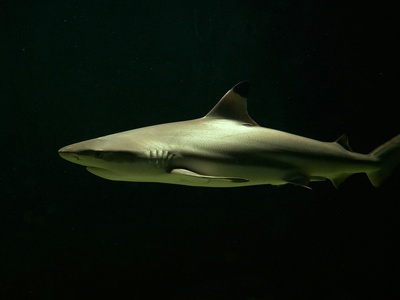
Dusky shark
A large, migratory shark that travels long distances. It is highly valued for its fins, leading to severe overfishing and its current status as an endangered species globally.
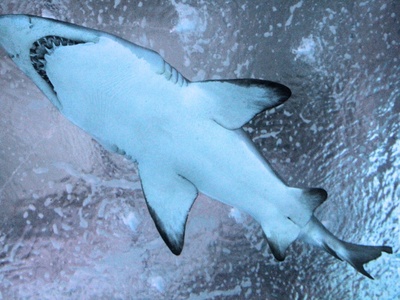
Sand tiger shark
A fearsome-looking but generally placid shark with ragged, protruding teeth. It is often found near the seabed. This species is critically endangered due to its low reproductive rate and overfishing.
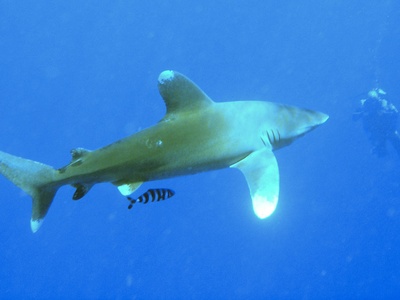
Oceanic whitetip shark
A once-abundant open-ocean shark, now critically endangered. It is recognized by its long, white-tipped pectoral fins. It is extremely vulnerable to bycatch in tuna fisheries.
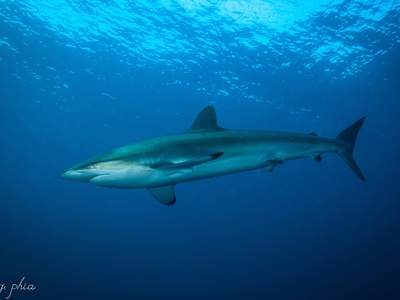
Silky shark
A sleek, slender shark of the open ocean, named for its smooth skin. It is often associated with schools of tuna and is heavily impacted by bycatch in purse seine and longline fisheries.
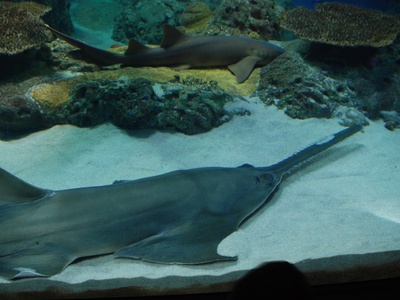
Smalltooth sawfish
A critically endangered ray with a long, flat snout lined with “teeth” (rostral denticles). Its rostrum gets easily entangled in fishing nets, and the Bijagós were a key historical habitat.

African wedgefish
A large, shark-like ray that is highly sought after for its fins, which are among the most valuable in the fin trade. This intense targeting has made it critically endangered.
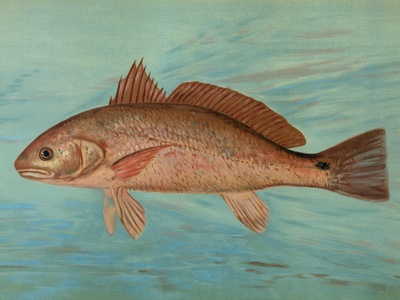
Acoupa weakfish
A large member of the croaker family, prized for its meat. It is an important predator in estuarine ecosystems and a significant target for both commercial and artisanal fisheries.
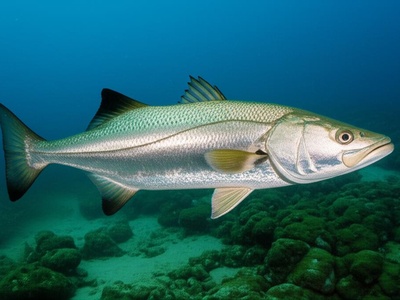
Meagre
A very large croaker that can reach over 2 meters. It is a prized commercial and sport fish, known to make loud booming sounds during its breeding season. Vulnerable to overfishing.
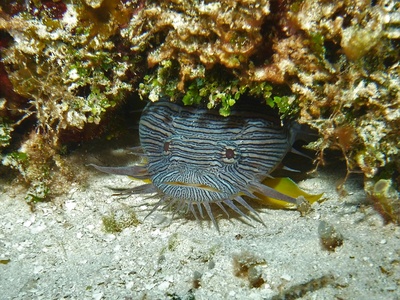
Porcupinefish
A slow-moving fish covered in sharp spines, which erect when it inflates its body into a sphere. This, along with its powerful neurotoxin, provides excellent defense against predators.
